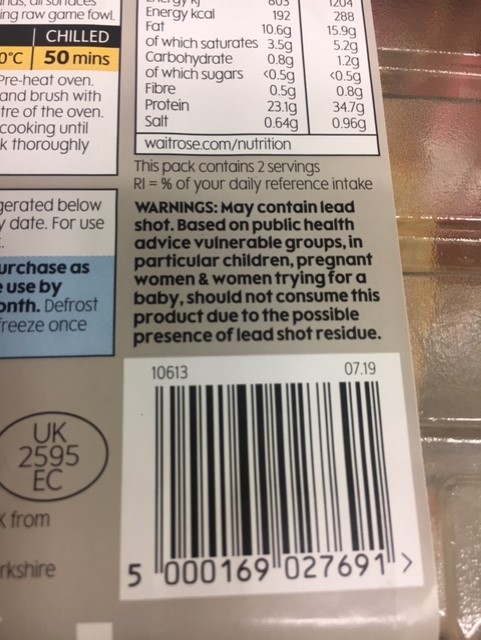Waitrose game meat still has lead in it – but signs of improvement
Introduction:
Yesterday we described the results of tests for lead levels which we commissioned on Game Mix and Pheasant breasts sold by Sainsbury’s. There are no maximum allowable lead levels set for game meat but there are maximum levels set for other meat such as pork, beef, chicken etc. We showed that Sainsbury’s game meat was usually way above the lead levels allowable for non-game meat. This is despite the fact that lead is a poison and is the subject of health warnings, particularly aimed at pregnant women, women trying for a baby, toddlers and young children. We analysed Sainsbury’s game meat because we considered their responses to customers on this issue to be misleading and evasive.
Are Sainsbury’s typical of other supermarkets? We don’t know except that Waitrose definitely appears to be different. Waitrose announced in July 2019 that from the 2020/21 shooting season it would only stock lead-free game birds. To do this it would source its game meat from suppliers who only used non-toxic ammunition, such as steel shot for killing Pheasants, Red-legged Partridges, Wood Pigeons etc..
As the game shooting season approached last year Waitrose shifted its position and blamed this on the coronavirus pandemic. This is what they said, and this notice is still on the Waitrose website (at least it was yesterday) but it is quite difficult to find (follow the link below and then scroll down a very long way).
Lead shot pledge
Waitrose & Partners is the largest retailer of game in the UK. We sell prepared wood pigeon, partridge and pheasant during the season. We are supplied by a single game dealer who ensures all the game source is from environmentally minded British shoots and reared to the highest standards. We monitor the shoots we source from and expect them to adhere to our bespoke standards of animal welfare and shoot behaviour.
From the 2019-20 season we began phasing out the use of lead shot on the Estates from which we source our game. We publicly stated that all the Estates we buy from will be required to use lead alternatives such as steel or bismuth from season 2020/21. We are disappointed that the COVID-19 outbreak has set back our plans as many of the Estates that supported our pledge are not shooting this season. However, we expect that more than half of the game on our shelves will be lead free during the 2020/21 season. As a result, our game will continue to carry the FSA lead warning which states “Consuming lead is harmful, health experts advise to minimise lead consumption as much as possible. Anyone who eats lead-shot game should be aware of the risks posed by consuming large amounts of lead, especially children and pregnant women.” In agreement with our game supplier, we are now pledging that by season 2021-22 all Waitrose & Partners game will be brought to bag without the use of lead ammunition.
https://www.waitrose.com/home/inspiration/about_waitrose/the_waitrose_way/waitrose_animal_welfarecommitments.html
So, when we bought game meat from Sainsbury’s earlier this year and sent it off to be analysed, we also bought 20 Waitrose whole Pheasants and took samples from them to be analysed too.
Methods:
The details of the collection, treatment and analysis of the samples were as described for Sainsbury’s meat samples yesterday.
Results:
Yesterday we showed you the results of lead analyses of Sainnsbury’s chicken meat and two game products; Game Mix and Pheasant breasts. In the table below those findings are reproduced with the two types of Sainsbury’s game meat combined on one line and the Waitrose data added.

Chicken: there were 20 samples, none had any detectable lead in them so the lead levels were below 0.04 units, and therefore 0/20 of the chicken samples were above the maximum allowable level which applies to chicken, pork, beef etc.. No problems there.
Sainsbury’s game: there were 30 samples, and 24/30 (ie 80%) had lead levels beyond the threshold of maximum allowable level which applies to beef, pork, chicken etc..
Waitrose game: despite having the highest single lead value of any of the meat samples we had tested, Waitrose game meat had a lower median and lower mean lead level than Sainsbury’s game meat. And 11/20 (ie 55%) of Waitrose samples were above the level allowable in non-game meat. There is evidence here that Waitrose really has tried to move towards lead-free game meat and with some success. That impression is enhanced by the fact that 0/30 of the Sainsbury’s game meat samples were below the detectable level of 0.04 units whereas 7/20 of the Waitrose samples were ‘lead-free’.
Discussion:
Sainsbury’s game meat has high lead levels and Waitrose game meat has lower lead levels. Both companies ought to do better and we will test their game meat and perhaps that of other game sellers next winter to see whether they are doing better.
There are some other differences too. Waitrose game meat has a health warning (see below) which refers to lead and its effects on children, Sainsbury’s does not. Waitrose have publicly stated that they are going ‘lead-free’, Sainsbury’s have not.

Wild Justice spent some time talking to journalists about this matter yesterday. Waitrose told a journalist that ‘game continues to be labelled for lead as per Food Standards Agency requirements‘ which is being unduly modest of them, since there are no FSA requirements to label game meat in that way. If there were, then Sainsbury’s and every other supermarket would be doing it, and it is, to the best of our knowledge, only Waitrose. So well done Waitrose.
Also, Sainsbury’s told a journalist in a statment which they said could be used publicly, that ‘Although it’s rare, it’s possible small traces of shot may remain in the product and this is explained on the packaging.’. Well that’s not true – all of Sainsbury’s game meat tested by us, that’s 30/30 samples, had detectable lead levels and many of them were spectacularly high lead levels. That doesn’t seem like small traces to us, and it’s not just ‘possible’ it seems to be normal. Lead is not mentioned on the packaging that we have seen. Sainsbury’s also claimed that ‘We can reassure our customers that testing shows any traces found in the product available from Sainsbury’s are within EU legal limits.’ which is true, in a way, in a very strange way, because there are no lead levels for game meat set by the EU and so Sainsbury’s could put a lump of lead on the shelf, call it a Pheasant and it wouldn’t be above the EU lead levels for Pheasant! It has been suggested in a scientific paper last year (see here) that there should be maximum allowable lead levels set for game meat because they don’t exist at the moment. Maybe Sainsbury’s will start lobbying the FSA and DEFRA to introduce such limits in this country? Do you think they will?
Sainsbury’s also told journalists that they are no longer selling the range of products we tested but it seems nobody thought to ask them whether they would be selling them again next season and what their plans are for selling game with or without lead in it. We will ask Sainsbury’s those questions and in any case we will test their game meat next winter.
Yesterday, as well as publishing our blog on Sainsbury’s game meat, Wild Justice sent out a newsletter to over 40,000 subscribers (you can subscribe to future issues here – they aren’t all about game meat) asking them what they thought should happen about regulation of lead ammunition and food quality. We also asked what our supporters thought about Sainsbury’s. We’ll publish the results of over 2,500 responses later today. It will make interesting reading for the FSA, Sainsbury’s, Waitrose, other vendors of game meat and DEFRA.
